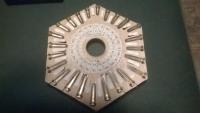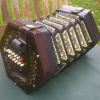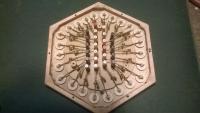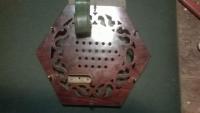-
Posts
81 -
Joined
-
Last visited
Posts posted by banjojohn
-
-
I bought at set of punches on ebay, which struggle to cut through just one layer of thin leather, any tips on a suitable method of re-grinding / sharpening?
-
I noticed that the action has staple-like pivot posts. might that give an idea of when it was made? were the staple posts used in the earlier lachenals?
From a quick glace at Lachenal trebles from S/n 10577 to 28070 (in the Concertina Museum collection), it would appear that two types of action pivots were being used, the bent brass staple and the curved top slotted brass sheet. Generally, it would seem that the staples were used on the budget models and the slotted sheet on the more expensive ones, with the exception of S/n 20678 which is a budget model with the slotted sheet pivots. Conclusion: I don't think you could use this as a means of dating...
-
Thanks Mike, Theo and Stephen, for your replies here, but any thoughts about the cut down reed pan labels?
Not that unusual...
Ok, so this is evident on a number of instruments, but for what reason was it done?
-
Thanks Mike, Theo and Stephen, for your replies here, but any thoughts about the cut down reed pan labels?
-
Can anyone advise where these very small diameter counter sunk steel wood screws can be obtained in the UK (in small numbers!)... ?
Also replacement case hinges and their screws too?
-
I have recently acquired this instrument, which is missing it's fret baffles and hence also missing the RH end label. After opening up to check the S/n, I noticed that the inner reed pan paper dials had been so cut as to remove the maker's name and address. I thought this was a bit strange, as other 're labelled' Lachenals which I have seen, still retain the full reed pan labels.
Has anybody seen this on any other instruments, or offer any explanation as to why this might have been done?

Also of note is the fact that there are valves fitted to all the highest notes, I had understood that this was incorrect, but have also noted it on quite a few similar instruments in the Concertina Museum collection?
What is the best source of info for Lachenal Serial number production dating, I have tried to date this but have been unable to find anything helpful on line (my internet search skills seem to be lacking!)
I include photos of the action and fret end to aid indentification/dating:
-
Post now withdrawn.
-
 Ah, thanks Alex... Erm it's all gone back to normal now!!!
Ah, thanks Alex... Erm it's all gone back to normal now!!! 
-
For some reason I am unable to post 'smileys' into these text editing windows (or for that matter any other text variations, as all icons at the top are 'greyed out' and un-selectable). Perhaps I would also have put a smiley face on my post too, if I had been able to... ? :-)
-
I find it slightly surreal when someone resurrects a thread that's nine years old. Orm, has it really taken you four years of reading old threads to find this?
You need to get a life mate, I mean seriously!

I have only recently become a member of this discussion forum and until now, very pleased to say that I have had extremely positive, informative and encouraging replies to post I have made. Peter, how do you suppose that I have been reading old threads for 4 years and more to the point what is so wrong with that? There is much of interest in posts both old and new. If you have nothing better to do on New Years Eve at 11 mins to midnight, than to criticise other members posts, then I seriously suggest that you are the one who needs to 'get a life'.... Big time!

-
I bought this instrument as a restoration project, with the view of getting it into a reasonable playable condition. However in the light of what I have now found out about it, I am wondering if it has more value in it's totally original condition, a collector's piece? Any advice of this question would be gladly received...
-
Thanks for this Geoffrey! I have just looked at the concertina museum's site and spotted two instruments which look identical in every respect to the W. Coleman labelled one which I have... Both are Ebblewhite labelled instruments. They are referenced C-374 and C-376 see at http://www.concertinamuseum.com/CM00374.htm
Noteable matching features of these 'improved concertinas' with the W. Coleman concertina are:
1) Bellows paper pattern
2) Fret work pattern
3) Countersunk fret end screws, with c/s domed washer
4) Action arms and pivots
5) Frameless action plate
6) Surface mounted reed shoes, screwed to reed pan
7) Wedge shaped reed valves
8) Colour of thumb strap leather
9) Attachment of bellows to the bellows frame (looks like there is another fold).
I would therefore conclude that the Coleman and the Ebblewhite labelled instruments were by the same maker...
I believe that most of these similarities (apart from #2 and #8) are at variance with the design and construction of contemporary English made instruments...
-
Mike, I'm interested to know about the tools you have used to cut the discs?
What are these tools called and where did you obtain them?
-
Any chance of some photos?
-
Difficult to comment, without a better idea of what proposals you have in mind.... ? Please elaborate more...
-
Thanks Bruce, this is most interesting... It just goes to show... Always something new to learn, and it seems this one was not understood by the maker of your instrument. What a simple fix for what would have been an incurable problem without this little gem of knowledge!
-
Thanks Greg, Stephen and David, for your informative comments above... I will follow the instructions in your manual David, and use a cut down dress makers pin to replace the one which is missing....
On the subject of valves: I replaced a number of these last night in Lachenal 32159, ones which were 'slapping' during play, but also notably both valves on the F note which I had been attempting to tune in a recent video (posted on C.net). I had concluded in my video, that this reed was probably fractured as it seemed to be sounding weaker and flatter when returned to the instrument. I now believe that the problem lay in the valve, as the reed is now sounding as strong as it's partner and also no longer flat! Whoopie !! Result... A big thanks for all your posts to all 'C.netters', I have learnt so much from this forum!
-
Please can anyone explain why there are pins in the chambers (presumably to stop the valve curling or opening too far), but no pins on the valves on the insides of the reed pans.... What is to prevent these inside valves from curling or opening too far?
I have just been replacing some valves on Lachenal 32159 and noticed that one of the chamber pins was missing, however the valve in question was showing no sign of curling, resting very flat against the wood. Should I bother to replace this pin?
-
'Hair side out'.... been thinking about this some more... Is the 'hair side' the side from which the animals hair grew, ie the smooth side of the leather, or is it the side of the leather which is rougher and with it's fibres, giving it a furry appearance?
-
I am also looking into doing some restoration work on fret ends... I searched forums using 'polish' and found this which may well be useful: http://www.concertina.net/forums/index.php?showtopic=13621&hl=%2Bvarnish+%2Bpolish&do=findComment&comment=134741
-
Dana, Thank you for your most detailed comments, I am very grateful to you for taking so much time to respond, thanks also to Jim for 'cracking the code' not to mention Don's delightful verse reference!!! Yes, I think I am beginning to understand this now!
-
From what I can see of your photograph, you have lost approximately 7% of the area of wood on this end, which is actually not that much... If this was my concertina, I wood definitely repair this end. To make a complete new end would be far more work and you would end up with something which would not really be an antique instrument. I would cut out a neat straight sided hole in the area(s) of damage. Then reassemble the 6 side frame, using a the bellows frame as a jig (to ensure accuracy). Now select suitable maghonany for the repair. Aged materials can be cheaply sourced from furniture junk shops if you are willing to spend a bit of time looking about.... Select a piece of wood which has similar colour and grain texture and cut a slice about 2mm thicker than you require, try to cut the slice as 'quarter sawn' in relation to the orientation of the grain direction in the slice. Plane the slice on both faces down to the correct thickness to match the existing fret end. Now mark out your patches, paying attention to the grain direction if the existing end. Cut the patches slightly over size and gradually bring them down to the correct size to fit the holes, by rubbing the edges on a sanding board (220 grit glass paper glued to a flat board). Keep checking the fit and make small adjustments until you have a good snug fit, with (hopefully) no gaps. Glue the patches into place before cutting the fretwork. Once the glue has gained its full strength you can cut the fretwork. Find a photo of the same fret work end and print out a life sized copy of the area you are going to cut, use this as a cutting pattern. Good luck and let us know how you get on?
-
I presume that correctly seasoned timber will have a 'memory' for the humidity level where it was seasoned and stored prior to being made into a reed pan... Don, I do hope that by maintaining a typical 'UK' level of humidity, given time of course, that your reed pan will stay flat enough, to once again become part of a functioning instrument.... I wish you good luck, from a very grey, damp and humid Oxfordshire!
-
I recently acquired an apparently French made English concertina (under the gloves in the photo). It has what seems to me to be a rather unusual (plain flat) reed pan, with surface mounted reed shoes, fixed with small screws. The reed valves are not the usual shape, but larger and wedge shaped, quite a few are badly 'gravity curled'... I am planning to replicate replacements and was hoping that the leather in these gloves might be a suitable source of material for this purpose...
For photos of the reed pan on this instrument, please see my other posted topic on this forum 'Concertina Maker or Distributer, W. Coleman & Co.' http://www.concertina.net/forums/index.php?showtopic=18324






Lachenal S/n 16011
in Concertina History
Posted
That's interesting 'D', thanks for your insight! So just to summarize the main points you have made:
1870 approx. date of S/n 16011
1873 approx. date of S/n 19070 (with Lachenal & Co pan labels) and name change from Louis Lachenal to Lachenal & Co.
If this dating of S/n 16011 is correct, there would have been no need for the pan labels to have the 'Louis' cut from them, as it was made before the name change..
So I have a conundrum, in that when I replace the baffles, what label do I glue to the RH side... A Louis Lachenal label might be correct to the time of manufacture, but this instrument may well have had some other retailer's label.. I don't suppose I will ever know who that would have been?